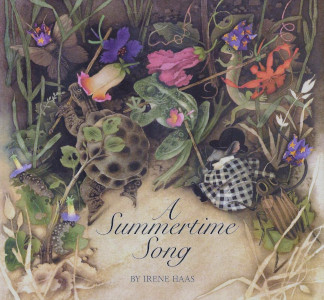A Summertime Song

Author:
Irene Haas
Illustrator:
Irene Haas
Publication:
1997 by Margaret K. McElderry Books
Genre:
Fairy Tales, Fiction, Picture Books
Pages:
32
Current state:
This book has been evaluated and information added. It has not been read and content considerations may not be complete.
Book Guide
Search for this book used on:
One warm summer night, a frog jumped into Lucy's room with an invitation for her to a birthday party and a magic paper party hat. Lucy
put it on, and out in the garden, when a moonbeam touched the hat, Lucy was as little as a leaf. So begins Lucy's wonderful adventure.A taxi driven by Baby Bird, who is afraid to fly, picks Lucy up to take her to the party. On the way, they stop for Madame Mouse, wearing a
brand new hat she's made; an inchworm determined to get to the party in time to have some birthday cake; and a tiny tattered old doll whose owner, for whom he still longs, had lost him in the shadows of moonlight long ago. But suddenly, a huge owl blocks their way—and he wants them all for his supper! Will they escape? Will they get to the party? Will the tiny doll ever be reunited with his beloved owner?In a lovely, lyrical text, the story unfolds to its happy ending. The magical pictures, painted with intricate detail and subtle colors, bring the moonlit garden world to life. This is an extraordinary book of great beauty and vivid imagination that small children and adults will look at again and again, discovering new wonders and surprises as they look. It is a treasure by the widely known and loved author/artist of The Maggie B.
From the dust jacket
To view an example page please sign in.
Resource Guide
Episode 70: Why Read Fairy Tales?
Released in 2020 by The Literary Life
Available formats: Streaming Audio
Length: 1 hr. 29 min.
View on the The Literary Life site
"Angelina Stanford and Cindy Rollins tackle the topic of fairy stories, discussing the what, why and how of reading them. Angelina shares the distinctive characteristics of fairy stories in contrast to other types of stories, such as myths. They deal with the question of whether fairy tales are 'escapist', the influence of the Grimm brothers scholarly work on interpreting fairy stories, and allowing the story to unveil its deeper truths without forcing meaning onto it.
Angelina gives an illustration of how to see the gospel messages in fairy tales by talking us through the story of Sleeping Beauty. She refutes the ideas that fairy tales are about human romance or are misogynistic. She also highlights some of the Enlightenment and Puritan responses to fairy tales that still linger with us today. Cindy and Angelina also discuss some common concerns such as the magical, weird, or scary aspects of fairy tales. Angelina also makes a distinction between folk tales, literary fairy tales, and cautionary tales."
Find This Book
Search for this book used on:




